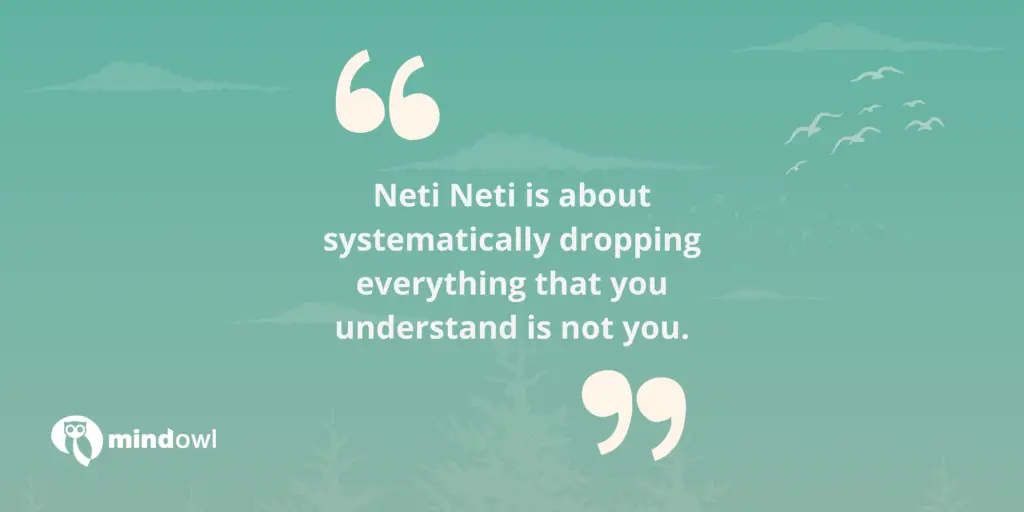What is the purpose of meditation? For many, it is about becoming more aware of how chaotic the human mind is, and learning how to cope with that. By increasing clarity and intentionality, we can better understand ourselves and our relationship with the world around us. There are a number of ancient forms of meditation that seek to examine our awareness of reality for this purpose. Today, we’re going to focus on one of them: the art of Neti Neti meditation.
What is Neti Neti?
Emerging over 8000 years ago in ancient India, this Sanskrit expression translates as “not this, not that”, or “neither this, nor that”. It dates back to the Upanishads, an old Vedic (relating to The Vedas, a large body of ancient Indian religious writing) text published between 700 and 500 BCE. This technique is all about finding stillness and peace of mind by withdrawing your attention from all the disturbances around you.
Neti Neti has strong links to the Hindu practice of jnana yoga, which uses chants or mantras to shift practitioners’ attention away from distractions. Within Neti Neti practice, meditators are encouraged to internally repeat mantras and statements such as “I have these thoughts, but I am not these thoughts”. Ultimately, the goal of this is to recognise that we are not defined by our thoughts and feelings.
This process is about systematically dropping everything that you understand is not you. For instance, if you can see the wall, then you are not the wall. If you can see your hand, then you are not your hand. The same principle can be applied to internal feelings. If you can notice and feel certain feelings, then you are not those feelings. This concept is about separating yourself from the chaos and turmoil of the mind, and trying not to let yourself get wrapped up in your own thoughts.
This extends to ruminations on future plans and intentions, as well as past memories. Essentially, anything you can experience, you are not that. This process of negation encourages the cultivation of a kind of emptiness, but one that includes and is aware of everything. Because Neti Neti doesn’t just mean “not this, not that” — it also means “also this, also that” (or in other words, “Iti, Iti”).
Self versus Non-self
You may think that this separation of the self and the non-self sounds pretty complicated. I don’t blame you — it can be hard to understand at first.
If you have any concerns about the spiritual-sounding nature of this practice, try to put them to the side for a moment. The fact is that the Neti Neti process is actually rooted in the everyday human experience.
Ultimately, it can be a pretty simple form of self-inquiry, based around this logic: If I perceive something, it can’t be me. Some people describe Neti Neti as an analysis of negation; by negating and ruling out what we are not, we can find out what we really are. This kind of analytical meditation is grounded in the concept of self-awareness and awareness of the human condition.
According to spiritual teacher Rupert Spira, Neti Neti recognises that the only element of experience that cannot be removed is the experience of being aware. Discussing the development in childhood of our ability to remove ourselves from the things we perceive, he states:
“Having separated ourselves from our surroundings, from our parents, and from others, we can continue that separating process. I’m not my thoughts either, they come and go just like my mother comes and goes. I am not my sensations, they come and go just like my father comes and goes.”
Spira’s statement embodies the premise of simply taking any thought or object that the mind can conceive and telling yourself neti neti―that that object is not the Supreme Reality. Traditionally, this form of meditation was used to get in touch with what Hindu philosophy calls Brahman, or ‘Absolute Reality’. But how can this idea help enrich our life? And can this form of meditation be used by anyone?

Who can practise Neti Neti Meditation?
Neti Neti may sound advanced, but it can be practised by anyone. In fact, if you’re directed well by an experienced meditation instructor, it can be one of the easier meditation techniques.
The function of Neti Neti meditation is to develop a better understanding of reality by separating yourself from your experiences.
This process can come naturally to some, but it may be a struggle for others; ultimately, it’s down to the individual. If you’re relatively new to meditation, you can practise this method for just a few minutes, beginning a gradual process of building up to longer sessions as they become easier. However, this form of meditation can also provide insight and clarity to the most expert meditator.
The ability to observe your own thoughts and feelings in a neutral way is key to developing a peaceful mind. Therefore, it’s not surprising that the ancient art of Neti Neti meditation is still popular for those practising mindfulness in the 21st century. That being said, it does have its limitations.
What are the limitations of Neti Neti?
According to some experts, Neti Neti can only get you so far, and it should be complemented by other forms of Jnana Yoga practice, which revolve around self-inquiry and contemplation.
According to certain practitioners, this form of meditation can seem futile at times. Like most meditative exercises, you often need to be in a certain frame of mind in order to practise it. It can be helpful to warm up in advance, and learn how to let go of the constant need for mental control and effort. For more on that, read our article on effortless meditation.
Regardless of whether or not you want to expand your awareness of Jnana Yoga and dive deeper into the spiritual roots of the practice, Neti Neti can be a transformative approach to understanding the world. You don’t need to ditch all other forms of mindfulness and concentrate just on this, but it’s worth keeping an open mind.
So how exactly does Neti Neti work? Let’s take a closer look at what a session usually consists of.
How to practise Neti Neti
We’ve now been through the origins and principles of this ancient meditative practice in some detail. It’s time for a step-by-step guide on how to practise Neti Neti meditation. Take your time and use this as an opportunity for self-inquiry, because each meditation instruction is designed to help you look inwards. Let’s go!
- First, sit quietly and close your eyes.
- Take a few deep breaths and begin to feel present in the moment.
- As a thought arises in your mind, be aware of it. As the thought grows, silently repeat to yourself: “Neti, neti, neti”.
- The first ‘Neti’ means: “I am not this thought”. The second ‘Neti’ means: “I am not the thought thinking this thought”. Finally, the third ‘Neti’ means: “I am not thought.” Use this process of repetition to separate yourself from the things happening inside your mind.
- Think of your observing self as the sky, with your thoughts representing the weather. Weather changes constantly, but the sky always has room for the heaviest rain, or the brightest sun. Whatever changes the weather experiences, the sky always rises above it, and detaches itself from it.
- Continue trying to watch and observe the thoughts that arise in your mind. Continue repeating the mantra of “Neti, neti, neti”.
- This may be difficult at first, but with time your mind will become more and more still. Try to be grateful for this stillness, and rest in it for as long as you can.
- Slowly open your eyes whenever you are ready.
This is a simple example of what a Neti Neti session might look like. The fundamental principle of this exercise is the idea that “this particular object is not you”. You can change this object depending on the situation; it could be your new role at work, some difficult feelings you’re having, the wall in front of you, or your pet cat. This level of flexibility means Neti Neti can be useful to basically anyone.
Why should I practise Neti Neti?
Training your mind to “disidentify” from the things it perceives can make you less prone to putting labels on everything. This can help us take in our experiences in ways that are slightly deeper. Adapting your mindset in this way can also make you a more tolerant, open-minded and curious person.
At first, when this exercise is focused mainly on the thoughts we contend with in our minds, it may seem futile or unattainable. However, as we continue this practice and expand the exercise into considering our body and our wider sense of self, the Neti Neti meditation process can help us detach ourselves from restrictive ideas of self. Breaking down the attachments and assumptions we’ve picked up throughout our lives can deepen our understanding of the world and of ourselves.
Both beginners and experienced meditators can benefit from this ancient meditation practice. The main reason for this is that the kind of intense introspection and awareness practice that Neti Neti encourages can be applied to many aspects of life ‘off-cushion’, so to speak.
If you think about it, this makes complete sense. The process of figuring out what doesn’t work for you in order to eventually arrive at what does comes naturally to most people. You might use this method when finding a romantic partner, or working out which job you’d like to do, for instance. Another area of life in which this method comes in handy is eating; when trying to develop a more mindful and conscious relationship with food, refining what works best for your body using this process can be helpful.
See, Neti Neti isn’t as strange and overly-spiritual as you may have first thought. There is real value in the process of questioning everything you think you know about yourself, and challenging your own view of the world. Spiritual teacher Amir Mourad believes that the phrase “whatever you think it is, that’s not it” encapsulates the idea that all the words, labels, and descriptions that humans create are just limiting concepts. At the end of the day, we still don’t understand everything that the mind is capable of. Therefore, it can be useful to try to break out of its structures.
Hopefully, you’ve found today’s introduction to Neti Neti meditation useful. As we’ve explored, if we dig beneath the surface and try to understand the benefits of ancient Eastern practices like this, we’ll find out that they can still be incredibly relevant today. Want to find out more? Check out our article on the Buddhist compassion technique of Tonglen Meditation.
MindOwl Founder – My own struggles in life have led me to this path of understanding the human condition. I graduated with a bachelor’s degree in philosophy before completing a master’s degree in psychology at Regent’s University London. I then completed a postgraduate diploma in philosophical counselling before being trained in ACT (Acceptance and commitment therapy).
I’ve spent the last eight years studying the encounter of meditative practices with modern psychology.










One thought on “Neti Neti Meditation: How to Find Your True Self”